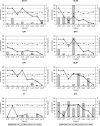Terrestrial vegetation and aquatic chemistry influence larval mosquito abundance in catch basins, Chicago, USA
- PMID: 23311394
- PMCID: PMC3549783
- DOI: 10.1186/1756-3305-6-9
Terrestrial vegetation and aquatic chemistry influence larval mosquito abundance in catch basins, Chicago, USA
Abstract
Background: An important determinant of mosquito-borne pathogen transmission is the spatial distribution of vectors. The primary vectors of West Nile virus (WNV) in Illinois are Culex pipiens Linnaeus (Diptera: Culicidae) and Culex restuans Theobald. In urban environments, these mosquitoes commonly oviposit in roadside storm water catch basins. However, use of this habitat is inconsistent, with abundance of larvae varying significantly across catch basins at a fine spatial scale.
Methods: We tested the hypothesis that attributes of the biotic and abiotic environment contribute to spatial and temporal variation in production of mosquito vectors, characterizing the relationship between terrestrial vegetation and aquatic chemistry and Culex abundance in Chicago, Illinois. Larvae were sampled from 60 catch basins from June 14 to October 3, 2009. Density of shrubs and 14 tree genera surrounding the basins were quantified, as well as aquatic chemistry content of each basin.
Results: We demonstrate that the spatial pattern of Culex abundance in catch basins is strongly influenced by environmental characteristics, resulting in significant variation across the urban landscape. Using regression and machine learning techniques, we described landscape features and microhabitat characteristics of four Chicago neighborhoods and examined the implications of these measures for larval abundance in adjacent catch basins. The important positive predictors of high larval abundance were aquatic ammonia, nitrates, and area of shrubs of height <1 m surrounding the catch basins, whereas pH and area of flowering shrub were negatively correlated with larval abundance. Tree density, particularly of arborvitae, maple, and pear, also positively influenced the distribution of Culex during the fruit-bearing periods and early senescent periods in August and September.
Conclusions: This study identifies environmental predictors of mosquito production in urban environments. Because an abundance of adult Culex is integral to efficient WNV transmission and mosquitoes are found in especially high densities near larval habitats, identifying aquatic sites for Culex and landscape features that promote larval production are important in predicting the spatial pattern of cases of human and veterinary illness. Thus, these data enable accurate assessment of regions at risk for exposure to WNV and aid in the prevention of vector-borne disease transmission.
Figures




Similar articles
-
Relationships between water quality and mosquito presence and abundance: a systematic review and meta-analysis.J Med Entomol. 2024 Jan 12;61(1):1-33. doi: 10.1093/jme/tjad139. J Med Entomol. 2024. PMID: 37832159 Free PMC article.
-
Weather variability affects abundance of larval Culex (Diptera: Culicidae) in storm water catch basins in suburban Chicago.J Med Entomol. 2012 Mar;49(2):270-6. doi: 10.1603/me11073. J Med Entomol. 2012. PMID: 22493843 Free PMC article.
-
Assessment of productivity of Culex spp. larvae (Diptera: Culicidae) in urban storm water catch basin system in Wrocław (SW Poland).Parasitol Res. 2016 Apr;115(4):1711-20. doi: 10.1007/s00436-016-4912-x. Epub 2016 Jan 25. Parasitol Res. 2016. PMID: 26809340 Free PMC article.
-
Production of Culex pipiens in Stormwater and Combined Sewer Catch Basins.J Am Mosq Control Assoc. 2020 Dec 1;36(4):249-252. doi: 10.2987/20-6934.1. J Am Mosq Control Assoc. 2020. PMID: 33647110
-
Meta-Analysis of the Relative Abundance of Nuisance and Vector Mosquitoes in Urban and Blue-Green Spaces.Insects. 2022 Mar 10;13(3):271. doi: 10.3390/insects13030271. Insects. 2022. PMID: 35323569 Free PMC article. Review.
Cited by
-
Spatial distribution and environmental correlations of Culex pipiens pallens (Diptera: Culicidae) in Haidian district, Beijing.J Med Entomol. 2024 Jul 12;61(4):948-958. doi: 10.1093/jme/tjae063. J Med Entomol. 2024. PMID: 38747350 Free PMC article.
-
Asymmetric effects of native and exotic invasive shrubs on ecology of the West Nile virus vector Culex pipiens (Diptera: Culicidae).Parasit Vectors. 2015 Jun 16;8:329. doi: 10.1186/s13071-015-0941-z. Parasit Vectors. 2015. PMID: 26076589 Free PMC article.
-
Relationships between water quality and mosquito presence and abundance: a systematic review and meta-analysis.J Med Entomol. 2024 Jan 12;61(1):1-33. doi: 10.1093/jme/tjad139. J Med Entomol. 2024. PMID: 37832159 Free PMC article.
-
Mosquito (Diptera: Culicidae) larval ecology in natural habitats in the cold temperate Patagonia region of Argentina.Parasit Vectors. 2019 May 7;12(1):214. doi: 10.1186/s13071-019-3459-y. Parasit Vectors. 2019. PMID: 31064397 Free PMC article.
-
Identification of larvicide-resistant catch basins from three years of larvicide trials in a suburb of chicago, IL.Environ Health Insights. 2014 Oct 13;8(Suppl 2):1-7. doi: 10.4137/EHI.S16014. eCollection 2014. Environ Health Insights. 2014. PMID: 25392699 Free PMC article. Review.
References
Publication types
MeSH terms
Substances
Grants and funding
LinkOut - more resources
Full Text Sources
Other Literature Sources

